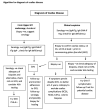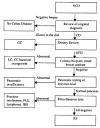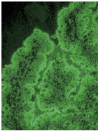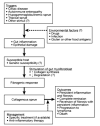Diarrhoea due to small bowel diseases
- PMID: 23384804
- PMCID: PMC3621726
- DOI: 10.1016/j.bpg.2012.11.013
Diarrhoea due to small bowel diseases
Abstract
Small intestinal diseases are a common, though often overlooked cause of diarrhoeal illness. Fully 1% of the Caucasian population are affected by coeliac disease and a substantial portion of children living in poverty in the developing world are affected by environmental enteropathy. These are but two examples of the many diseases that cause mucosal injury to the primary digestive and absorptive organ in our body. While diarrhoea may be a common, though not universally seen symptom of small bowel mucosal disease, the consequent malabsorption can lead to substantial malnutrition and nutrient deficiencies. The small intestine, unlike the colon, has been relatively inaccessible, and systematic evaluation is often necessary to identify and treat small intestinal mucosal diseases that lead to diarrhoea. Immunodeficiency states, including HIV enteropathy, adult autoimmune enteropathy, drug-associated enteropathy, and tropical sprue continue to occur and require specific therapy. All patients with severe diarrhoea or diarrhoea associated with features suggestive of malabsorption may have a disease of the small intestinal mucosa that requires careful evaluation and targeted management.
Copyright © 2012 Elsevier Ltd. All rights reserved.
Figures












Similar articles
-
[Chronic diarrhoea: when is it celiac disease and when not?].Dtsch Med Wochenschr. 2024 Mar;149(7):353-360. doi: 10.1055/a-2057-3978. Epub 2024 Mar 13. Dtsch Med Wochenschr. 2024. PMID: 38479419 German.
-
Review article: Small intestinal bacterial overgrowth, bile acid malabsorption and gluten intolerance as possible causes of chronic watery diarrhoea.Aliment Pharmacol Ther. 2009 May 15;29(10):1069-77. doi: 10.1111/j.1365-2036.2009.03970.x. Epub 2009 Feb 15. Aliment Pharmacol Ther. 2009. PMID: 19222407 Review.
-
The biopsy pathology of non-coeliac enteropathy.Histopathology. 2015 Jan;66(1):29-36. doi: 10.1111/his.12522. Histopathology. 2015. PMID: 25234408 Review.
-
The malabsorption syndrome.Med Clin North Am. 1973 Jul;57(4):907-23. doi: 10.1016/s0025-7125(16)32241-6. Med Clin North Am. 1973. PMID: 4197139 Review. No abstract available.
-
Malabsorption syndromes in infancy and childhood. II.J Pediatr. 1972 Nov;81(5):867-84. doi: 10.1016/s0022-3476(72)80537-7. J Pediatr. 1972. PMID: 4117588 Review. No abstract available.
Cited by
-
Diagnostic Yield and Clinical Impact of Video Capsule Endoscopy in Patients with Chronic Diarrhea: A Korean Multicenter CAPENTRY Study.Gut Liver. 2017 Mar 15;11(2):253-260. doi: 10.5009/gnl16231. Gut Liver. 2017. PMID: 27840367 Free PMC article.
-
Whipple Disease With Central Nervous System Involvement.Fed Pract. 2024 Dec;41(12):418-421. doi: 10.12788/fp.0542. Epub 2024 Dec 18. Fed Pract. 2024. PMID: 40530372 Free PMC article.
-
Autoimmune Enteropathy in an Ulcerative Colitis Patient.ACG Case Rep J. 2018 Nov 7;5:e78. doi: 10.14309/crj.2018.78. eCollection 2018. ACG Case Rep J. 2018. PMID: 30465008 Free PMC article.
-
VIP in HIV Diarrhea: Finding Links for the "Slim Disease".Front Physiol. 2015 Dec 23;6:402. doi: 10.3389/fphys.2015.00402. eCollection 2015. Front Physiol. 2015. PMID: 26779028 Free PMC article. No abstract available.
-
Review: chronic and persistent diarrhea with a focus in the returning traveler.Trop Dis Travel Med Vaccines. 2017 May 4;3:9. doi: 10.1186/s40794-017-0052-2. eCollection 2017. Trop Dis Travel Med Vaccines. 2017. PMID: 28883979 Free PMC article. Review.
References
-
- Rubio-Tapia A, Ludvigsson JF, Brantner TL, Murray JA, Everhart JE. The prevalence of coeliac disease in the United States. Am J Gastroenterol Oct. 2012;107(10):1538–44. - PubMed
-
- Green PH, Cellier C. Celiac disease. N Engl J Med. 2007 Oct 25;357(17):1731–43. - PubMed
-
- Rampertab SD, Pooran N, Brar P, Singh P, Green PH. Trends in the presentation of celiac disease. Am J Med. 2006 Apr;119(4):e9–14. (355) - PubMed
Publication types
MeSH terms
Substances
Supplementary concepts
Grants and funding
LinkOut - more resources
Full Text Sources
Medical

